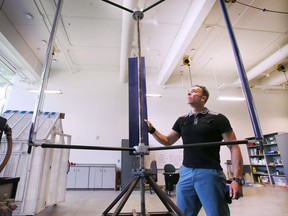
Article content
Ontario greenhouse industry officials say a new joint venture that explores using existing wind turbines to directly provide electricity and hydrogen to local greenhouses is an example of the micro-generation needed to meet the region’s growing demand for power.
Advertisement 2
Article content
The Hydrogen Integrated Greenhouse Horticultural Energy partnership, which includes the Ontario Greenhouse Vegetable Growers, the University of Windsor and Kruger Energy, is putting together the economic and regulatory modeling required to launch a pilot project in a year.
The project ultimately proposes building a commercial facility that uses wind turbines to produce electricity and hydrogen that greenhouse operators can access without the need of the region’s main transmission lines.
“I think it’s an opportunity to look at renewables,” said Ontario Greenhouse Vegetable Growers general manager Joe Sbrocchi.
I’m optimistic the project will prove successful
We’re looking at multiple avenues to create a green and circular economy.
“This would remove demand on the grid. That helps other sectors too, such as electric vehicles and the other stuff that goes with it, to continue to grow.”
advertisement 3
Article content

The Ontario Greenhouse Vegetable Growers’ membership grows tomatoes, cucumbers, peppers, strawberries and other food crops.
Sbrocchi added the creation of hydrogen would also help reduce the greenhouse industry’s carbon footprint. Clean-burning hydrogen is already being infused into the natural gas that heats the greenhouses, but this would allow for expansion of that along with powering vehicles.
“This project increases our electrical capacity and reduces our environmental impact,” Sbrocchi said. “It’s a win-win situation and it doesn’t require the building of more turbines.
“I’m optimistic the project will prove successful.”
Sbrocchi said electric capacity in Southwestern Ontario has been a growing concern for a decade. Companies have hesitated to expand without assurances there’ll be power available when needed.
advertisement 4
Article content
I have estimated 75 to 80 per cent of the 3,500 acres under glass in Ontario is located locally.
The issue drew closer scrutiny recently when questionable power availability led LG Chem to cancel a site visit for a potential $2.5-billion plant in Essex County.
The Independent Electricity Systems Operator, which oversees Ontario’s electricity market, has since assured there are local generation opportunities to meet the short-term demands of the region.
University of Windsor engineering professor Rupp Carriveau, who is also director of the school’s Environmental Energy Institute, said the project is also a perfect fit for Essex Power Corp.’s plans to create a local electricity market within IESO’s bulk market. The market would supply area firms with locally generated power.
advertisement 5
Article content
“The need has become more public, especially with the economic announcements of the past two weeks,” Carriveau said.
“Five years ago, we knew this (capacity issues) was happening, but no one cared. Now people care.
“I think you’re going to see more and more mini distribution systems like this.”
As part of putting together the final business case to launch the pilot project, Carriveau said the province will need to make regulatory changes to allow power to be supplied directly to the greenhouses.
The greenhouse industry has committed to covering the costs of hooking up lines and Carriveau said there are also private equity firms interested in investing in the project.
“The government (ministries) have been supportive,” said Carriveau, who added the pilot project would be based in Essex County. “They want a list of us of the specifics we need to be addressed to make this work.
advertisement 6
Article content
“This would be a huge economic enabler for the local economy. It would eliminate some serious constraints and we’d see our carbon signature improve.
“We also think it’s something that could be replicated across the country.”
Another benefit is the plan will use existing infrastructure. That, combined with the wind as a power source, has Carriveau optimistic the project’s power costs will be competitive.
Montreal-based Kruger Energy’s two wind farms in Kent County and at Port Alma generate a combined 200 megawatts, which is enough to power 60,000 homes or hundreds to thousands of greenhouse acres, depending on the crop.
The company has 42 power-producing facilities across North America with a generation capacity of 542 megawatts.
“We’re pleased at the prospect of an additional market for our energy solution,” said Kruger’s general manager of Canadian operations JJ Davis.
“Kruger is a leader in sustainability and strategic asset management, which will enable us to reliably supply clean energy to the vegetable greenhouse sector.”
Twitter.com/winstarwaddll